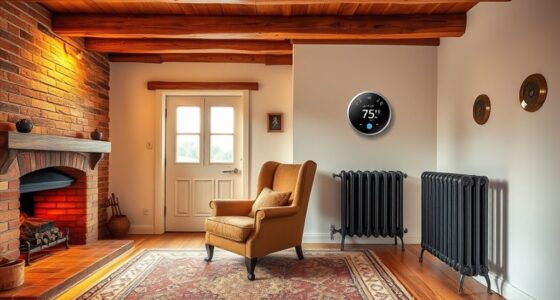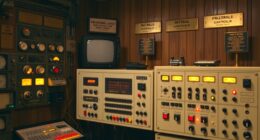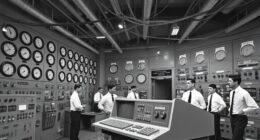Early visions of smart homes, driven by science fiction and inventors, imagined intelligent houses that could anticipate your needs, with robotic kitchens, virtual butlers, and voice-activated controls. These ideas shaped how we design today’s homes, pushing innovations like automated lighting, smart appliances, and responsive environments. The future of home technology builds on these imaginative beginnings, transforming how we live. Keep exploring to see how these dreams continued to evolve into the smart homes of today.
Key Takeaways
- Early science fiction envisioned homes with robotic kitchens and virtual butlers managing chores and schedules.
- Inventors conceptualized voice-activated lighting and automation systems decades before mainstream adoption.
- Sci-fi inspired sleek, high-tech architectural designs with glowing accents and adaptable layouts.
- Advanced technologies like smart appliances and robotic assistants mimic these futuristic visions today.
- Imagination-driven ideas, such as moving walls and holographic interfaces, continue shaping modern smart home innovations.
Early Visions of Automated Living
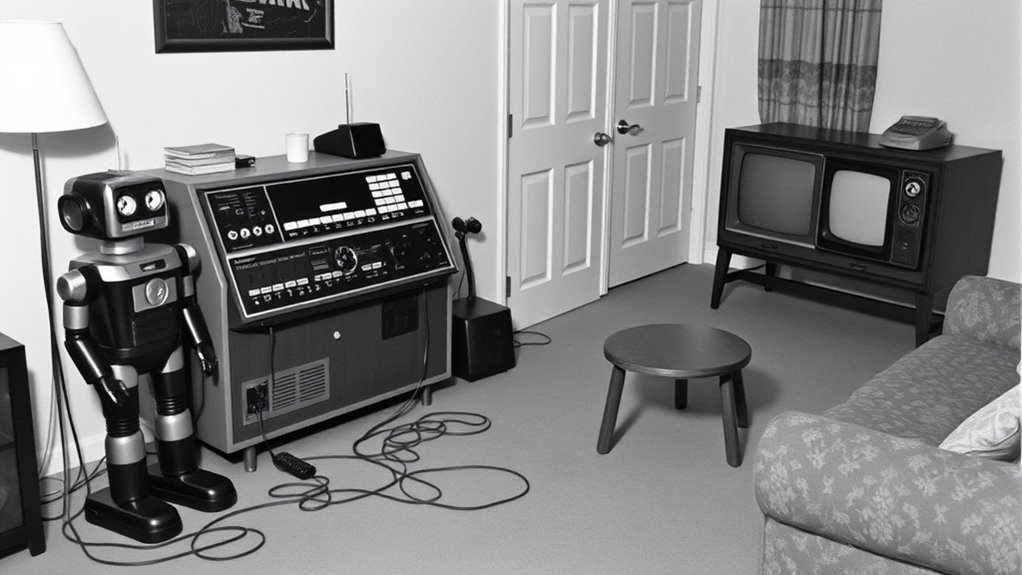
Early visions of automated living often appeared in science fiction, imagining homes filled with intelligent machines that could anticipate and fulfill residents’ needs. You might picture robotic kitchens that prepare meals effortlessly, adjusting recipes to your preferences and dietary requirements. Virtual butlers would manage your schedules, control household devices, and even handle cleaning tasks. These futuristic concepts promised a seamless lifestyle, where technology anticipated your every need and made daily routines effortless. Although these ideas seemed far-fetched at the time, they laid the groundwork for real-world innovations. Today’s smart homes incorporate many of these visions, turning science fiction into reality. You can now experience a level of convenience once reserved for dreams—thanks to early imaginations of robotic kitchens and virtual butlers. Additionally, advancements in home theatre projectors and audiovisual technology have further enhanced the immersive experience of modern smart homes.
The Influence of Science Fiction on Home Design
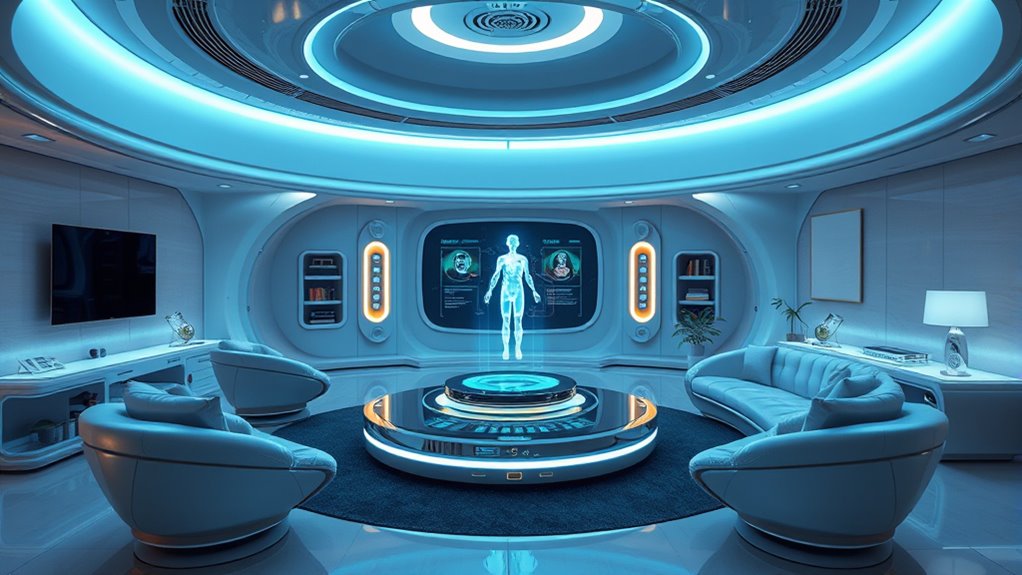
Science fiction has shaped your ideas of what home design could be, introducing futuristic concepts that seem almost real today. Many sci-fi technologies, once imagined, are now becoming part of everyday life. Your imagination continues to inspire innovation, pushing the boundaries of what’s possible in smart home design. For example, the integration of home automation systems is a direct result of science fiction’s influence, transforming how we control and interact with our living spaces.
Futuristic Home Concepts
Futuristic home concepts have been heavily shaped by science fiction, inspiring architects and designers to push the boundaries of traditional living spaces. You might envision interiors with sleek, seamless surfaces, glowing accents, and adaptable layouts that change with your needs. Architectural styles often blend organic shapes with high-tech materials, creating a sense of harmony between nature and innovation. These concepts emphasize open floor plans, multi-functional spaces, and dynamic lighting that reacts to your mood. Some designs incorporate floating structures or transparent walls, making the home feel more like a sci-fi set than a conventional residence. The influence of science fiction fuels creative ideas, inviting you to imagine a future where your home is both a sanctuary and a marvel of technological artistry. Additionally, AI-powered virtual reality in e-learning could revolutionize how we visualize and interact with these futuristic designs before they are built.
Sci-Fi Technologies Realized
Science fiction has long envisioned advanced home technologies that now serve as real-world inspirations, transforming how we design and use living spaces. These ideas have shaped modern concepts like cybernetic living and robotic domesticity, making our homes smarter and more adaptable. One example is how smart appliances now mimic sci-fi’s intuitive interfaces, enabling seamless control. 1. Voice-activated assistants and smart appliances mimic sci-fi’s intuitive interfaces, enabling seamless control. 2. Automated systems for lighting, climate, and security reflect the futuristic vision of interconnected living environments. 3. Robotics integrated into daily routines, from cleaning to caregiving, embody the cybernetic living concept.
These innovations demonstrate how sci-fi has influenced home design, turning imaginative futures into tangible realities, and paving the way for truly intelligent homes.
Imagination Inspires Innovation
Imagination has always played a crucial role in shaping the homes of tomorrow, inspiring designers and engineers to turn visionary ideas into reality. Science fiction fuels this creative process, blending artistic expression with technological optimism. Your mind envisions homes where walls shift like paper, and furniture responds to your mood. This vision is reflected in the following imagery:
| Walls that shift | Robots as assistants | Holographic interfaces |
|---|---|---|
| Furniture that moves | Self-cleaning surfaces | Voice-activated systems |
| Transparent ceilings | Sensory lighting | Automated climate control |
These concepts, born from sci-fi, push the boundaries of what’s possible. Your imagination sparks innovation, transforming distant ideas into tangible, smart home solutions that enhance everyday life. Exploring sensor technology can further inspire the development of responsive environments in future homes.
Pioneering Inventions That Foretold Smart Homes
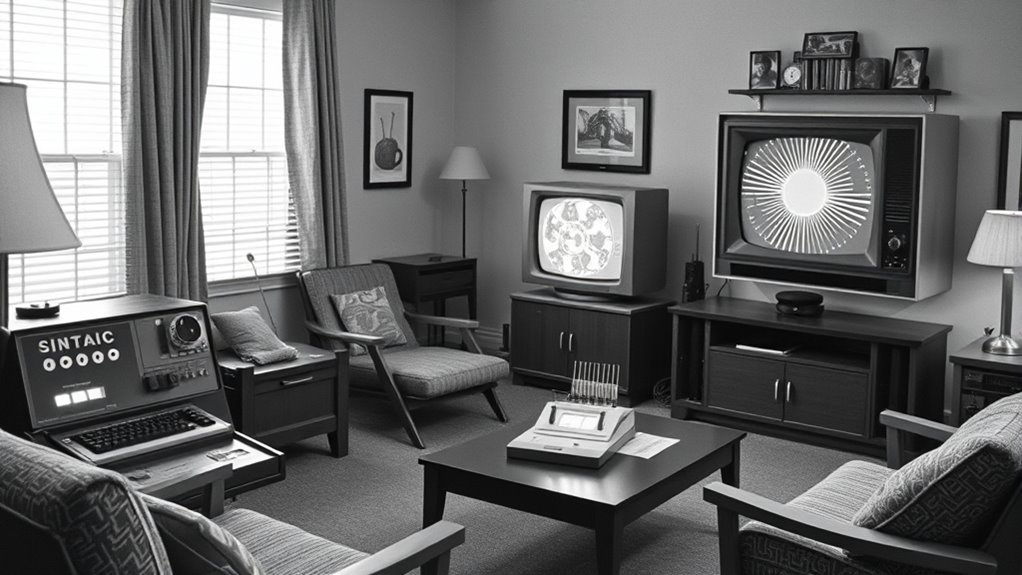
Have early inventors anticipated the interconnected homes we envision today? Some groundbreaking ideas pointed directly to future smart homes. For example, inventors imagined robotic kitchens that could prepare meals automatically, saving time and effort. They also envisioned voice-activated lighting systems that respond instantly to commands, creating a seamless living experience. Additionally, the integration of smart technology into household appliances and systems was envisioned long before it became commonplace today.
How 20th Century Technologies Sparked Imagination
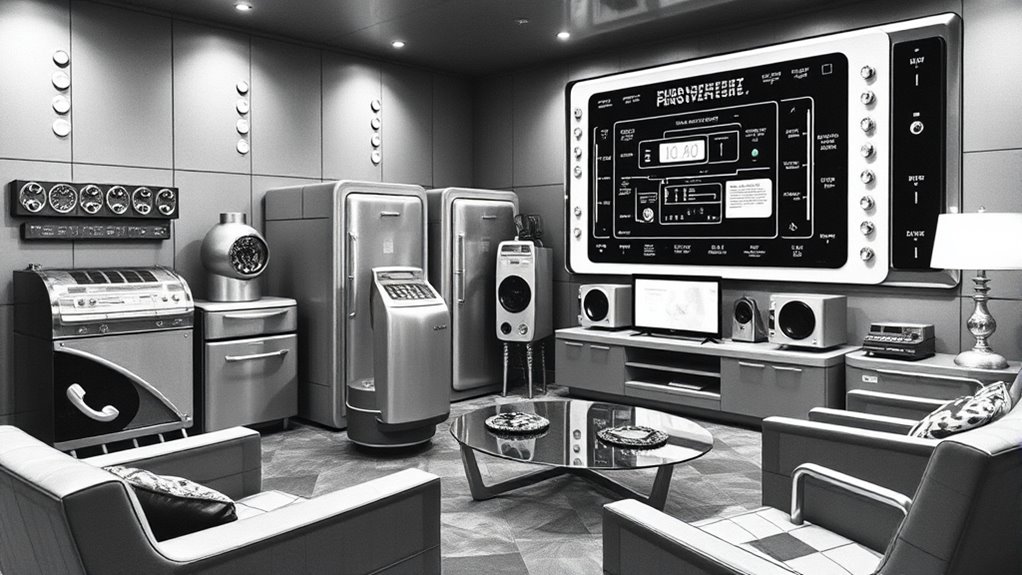
How did technological innovations of the 20th century ignite visions of the smart homes we see today? Advances like electrical appliances and automation transformed interior decoration, making homes more modern and stylish. People began imagining a future where household chores could be effortless with devices that automate cleaning, cooking, and maintenance. The introduction of appliances like vacuum cleaners, refrigerators, and washing machines sparked ideas of a fully automated household. These innovations fueled dreams of a home that could respond intelligently to your needs, reducing manual effort and increasing comfort. As technology progressed, the line between practical tools and futuristic visions blurred, inspiring writers and designers to imagine living spaces that would seamlessly integrate technology into everyday life. Additionally, the growth of home automation systems laid the groundwork for the interconnected, intelligent environments we envision today.
The Role of Radio and Wireless Communication

Did wireless communication truly revolutionize the concept of smart homes? Absolutely. The radio influence sparked the wireless revolution, making remote control and automation possible. This innovation transformed how people envisioned future homes. Consider these key impacts:
- Remote Control: Early ideas imagined controlling appliances via radio signals, reducing manual effort.
- Connectivity: Wireless communication bridged devices, creating interconnected systems that shared information seamlessly.
- Automation: Radio-based systems enabled homes to respond automatically to commands, laying the groundwork for modern smart technology.
- Privacy Policy: The use of cookies and data tracking in these systems raised important considerations about user privacy and data security.
Imagining a Home That Thinks and Acts
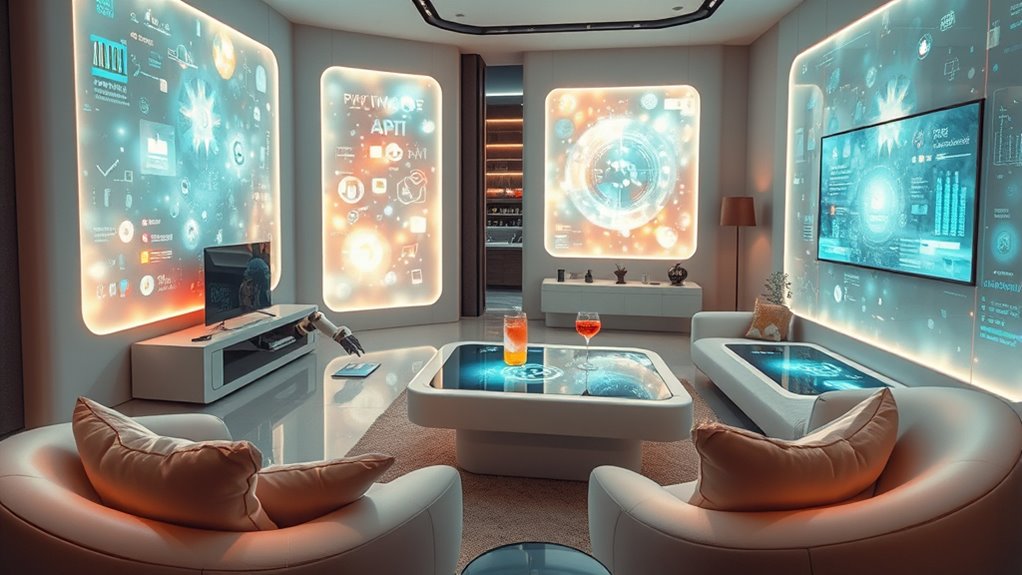
Building on the foundation of wireless communication, the future of smart homes envisions environments that don’t just respond to commands but anticipate your needs. Imagine urban architecture seamlessly integrating intelligent systems that adapt to your daily routines, making your home more intuitive. Inside, interior aesthetics blend technology with design, creating spaces that shift lighting, temperature, and even layout based on your preferences. Walls might detect your mood and adjust colors, while furniture moves to optimize comfort or space. You become part of an environment that thinks and acts, transforming your home into a responsive, personalized sanctuary. This intelligent interplay between architecture and interior design ensures your living space is both functional and visually harmonious, elevating everyday living to a new level. Additionally, advances in automation technologies enable these homes to learn from your habits and improve their responsiveness over time.
The Legacy of These Ideas in Today’s Smart Technology

The ideas from the vision of a home that thinks and acts have profoundly shaped today’s smart technology. They laid the foundation for the smart home evolution, influencing how we approach modern automation. Today, you benefit from these early concepts through:
- Integrated systems that communicate seamlessly, streamlining daily routines.
- Voice-activated controls that make managing devices effortless.
- Predictive automation that learns your habits to optimize energy and comfort.
These innovations reflect how past imaginations continue to inspire practical, user-friendly solutions. What once was science fiction now drives the smart home industry, making your home smarter, more responsive, and more intuitive than ever before. The legacy of those early ideas remains central to modern automation’s progress.
Frequently Asked Questions
How Did Early Inventors Envision Household AI Functioning?
Early inventors envisioned household AI as highly advanced, imagining robotic butlers that could perform chores effortlessly. They also imagined voice command innovations allowing you to control everything with simple spoken instructions. You’d have a personal assistant that manages your home, takes care of tasks, and responds instantly to your commands. This futuristic vision aimed to make everyday life more convenient, blending automation and intelligence seamlessly into your home environment.
What Cultural Influences Shaped Visions of Future Home Automation?
Ever wonder what shaped our visions of home automation? Cultural influences like technological determinism pushed us to see technology as inevitable, fueling both utopian and dystopian narratives. These stories reflect societal hopes and fears, shaping how we imagined smart homes. Did we dream of convenience or control? These visions reveal much about our values and anxieties, influencing how technology integrates into our daily lives today.
Were There Any Practical Experiments or Prototypes in Early Smart Homes?
You’ll find that early smart homes featured several practical experiments and experimental prototypes. Inventors and researchers tested technologies like automated lighting, voice control, and early home security systems. These practical experiments helped refine concepts and demonstrate feasibility, paving the way for modern smart home devices. By exploring these prototypes, you see how innovation was driven by real-world testing, shaping the future of home automation technology.
How Did Public Perception of Automation Evolve Over the 20TH Century?
You see, public perceptions of automation evolved substantially over the 20th century. Societal attitudes shifted from excitement and optimism during early technological breakthroughs to skepticism amid concerns about job loss and privacy. As automation became more integrated into daily life, people grew more cautious, balancing curiosity with wariness. Today, you recognize that society’s view continues to adapt, reflecting both the benefits and challenges of technological progress.
What Ethical Considerations Were Raised by Early Smart Home Concepts?
Imagine a home where your every move is monitored—early smart home ideas raised serious ethical questions about privacy concerns and societal impacts. You might worry about who controls your data and how it could be misused. These concerns prompted debates about consent and security, shaping future smart technology. As you embrace automation, remember that safeguarding your privacy remains essential to prevent potential societal harms.
Conclusion
As you look around your own smart home, you realize how those early visions shaped today’s reality. But what’s next? Will tomorrow’s innovations surpass your wildest dreams, or will they bring surprises you never saw coming? The future of automated living is still unfolding, and you’re part of it. Keep imagining, because the next breakthrough could be just around the corner—waiting quietly to change everything you thought you knew about home.


